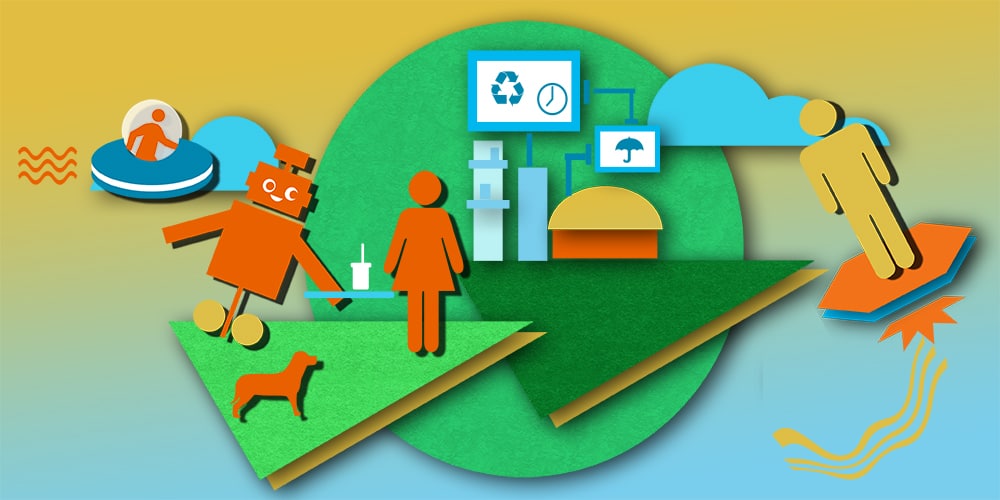As the year ticks to a close, many begin to look toward the future. In honour of the approaching new year, The Varsity’s science writers have made dramatic predictions for the future. Where will we be in 100 years?
Unmanned surveillance will change privacy

TAKAKO NOMURA/THE VARSITY
Canada has become a world leader in the design and production of unmanned aerial vehicles (UAVs). These drones are not susceptible to human error, and are fully autonomous — they can sense their surroundings, react almost instantaneously, and fly in formation, coordinating with other UAVs. They also can be produced inexpensively— your neighbour has probably built one in his basement to spy on you.
The implications for surveillance and military operations are huge: illegally crossing a border is not merely a matter of evading the border patrol officers, but also of evading the thousands of uavs that monitor every stretch of ground, sending real-time updates and video footage of suspicious activity to a massive computer system. If privacy is disappearing now, it will become non-existent.
These drones are easily disguised, and are used by law enforcement agencies, espionage agencies, and military organizations to monitor the general population. The development of new methods of statistical analysis to sort through all this data will be a hot topic in international research. Finally, although there is no lack of public outcry, most passenger aircraft will qualify as uavs and will be flown entirely by computers.
— Jennifer Hurd
Sight will be digitized
 There has been a lot of buzz lately about Google Glass and other wearable tech. But so far, nobody yet can see like Geordie La Forge in Star Trek: The Next Generation. La Forge, blind from birth, gains sight with a VISOR that attaches directly to his optic nerve. The VISOR allows him to detect and distinguish between electromagnetic radiation in the infrared, visible, and ultraviolet regions.
There has been a lot of buzz lately about Google Glass and other wearable tech. But so far, nobody yet can see like Geordie La Forge in Star Trek: The Next Generation. La Forge, blind from birth, gains sight with a VISOR that attaches directly to his optic nerve. The VISOR allows him to detect and distinguish between electromagnetic radiation in the infrared, visible, and ultraviolet regions.
If VISOR technology existed and was made widely available in our time, we would have a universal cure for blindness. After that miraculous event, imagine the possibilities! VISORs would completely change the perception of our world. Artists would have their palettes expanded in an unprecedented way, and the technological developments that VISORs would allow are staggering.
As for neutrinos, the current method of neutrino detection involves a massive tank of water, through which the majority of neutrinos fly without interacting. Detecting neutrinos is difficult, but learning about their properties is very important for particle physics and especially for astronomy. With VISOR technology, we could replace the giant neutrino tanks with a few VISOR-equipped observers. Their job? Nothing less than peering into the vastness of space, hoping to see something magnificent, and they would.
— Emma Hansen
Aging won’t be an issue
 It seems inevitable that humans are still going to be aging in the future. However, scientists have been pondering whether aging is avoidable or not. Thinking about a possible “fountain of youth,” brings up the mystery of what causes biological aging.
It seems inevitable that humans are still going to be aging in the future. However, scientists have been pondering whether aging is avoidable or not. Thinking about a possible “fountain of youth,” brings up the mystery of what causes biological aging.
Several theories of aging have floated around the scientific community, including one that suggests that the physical aging of our bodies is due to the gradual shortening and damaging of our DNA as our cells replicate it.
It seems that preventing this gradual degradation of DNA and rebuilding the “lost” parts of DNA could become possible in the future. Research is currently underway as to how to repair DNA, but it will probably take a number of years to develop.
Science fiction has already suggested a process to delay aging called cryonics. This is a type of preservation that freezes the body in a suspended state, preventing aging due to the freezing of the cells and DNA replication process. The body is kept frozen until it is possible to bring the body back to life, maybe a hundred years from now, when the process of aging is ancient history.
— Jonathan Ignacio
We will individualize the process of learning
 The initiation of the Human Brain Project funded by the European Union (EU) and a similar BRAIN Initiative in the USA may, in the next 100 years, lead to a complete map of the brain.
The initiation of the Human Brain Project funded by the European Union (EU) and a similar BRAIN Initiative in the USA may, in the next 100 years, lead to a complete map of the brain.
My prediction is that in the next 100 years, brain wave analysis will give us more accurate insight on how to teach a person new concepts in order to minimize the time spent teaching them and maximize their productivity.
Each student will be fitted with a brain-sensing device that will wirelessly connect to a mobile device so that the teacher can accurately assess what parts of the brain show more activity in the learning process. Wearable brain sensing devices have already been released to the market; however, these are just prototypes that require a little tweaking to achieve great success.
— Mary Githumbi
Science will change its public image
 Soon , I hope, science will be accessible to everyone. Education in science and math will teach more than computation; it will be engaging and fun. More than that, good science education will be globally available.
Soon , I hope, science will be accessible to everyone. Education in science and math will teach more than computation; it will be engaging and fun. More than that, good science education will be globally available.
We’ll find ways to tell the stories of some of humanity’s most beautiful achievements. We may not be able to hang quantum theory in an art gallery, but that shouldn’t mean that it is inaccessible to non-scientists.
Popular books are a great place to start, and it’s my sincere hope that practitioners of science will continue to communicate their discoveries to the general public, so that everyone can share in the excitement.
With this increased awareness of science, our respect for science will be tempered by an understanding of its limitations. We will stop idolizing science as an omniscient, Orwellian force, and we will see it for what it is: beautiful and magnificent, but ultimately a human enterprise, and therefore fallible.
As Joseph Rotblat said in his Nobel lecture, it becomes increasingly clear that we need to ensure that science does not “[become] identified with death and destruction.” We need to keep listening to the Sagans, the Einsteins, and the Rotblats of the world.
— Emma Hansen


